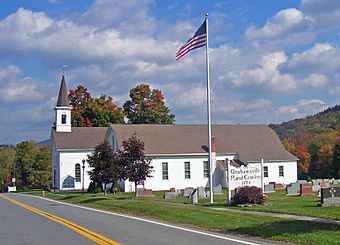Grahamsville Historic District facts for kids
Quick facts for kids |
|
|
Grahamsville Historic District
|
|

Grahamsville Reformed Church
buildings and cemetery, 2007 |
|
| Location | Grahamsville, NY |
|---|---|
| Nearest city | Middletown |
| Area | 20 acres (8 ha) |
| Built | 19th century |
| Architectural style | Italianate, Greek Revival, Gothic Revival |
| NRHP reference No. | 79001634 |
| Added to NRHP | December 6, 1979 |
The Grahamsville Historic District is a special area in Grahamsville, NY. It's a collection of old buildings that show how people lived long ago. You can find it along Route 55 in Sullivan County.
This historic district was added to the National Register of Historic Places in 1979. This means it's recognized as an important place in American history. The district covers about 20 acres (8 hectares) and includes five main buildings.
The most important building is the Grahamsville Reformed Church. It was first built in the 1840s. Later, in 1874, it was made bigger, and a cemetery was added. There's also an old boarding house from 1847. Today, this house is used as an art gallery.
Contents
A Look Back: Grahamsville's Story
The area where Grahamsville is today was first settled a very long time ago. This was during the colonial era, before the United States was a country. But during the Revolutionary War, some people who supported the British (called Loyalists) and their Native American allies attacked the area. This caused many settlers to leave.
After the United States became independent, new people were invited to settle here. The area was named after an officer whose unit had been attacked nearby. The first known house in Grahamsville was built in 1788.
Early Life and Lumber Business
Farming was difficult in this region. So, people turned to cutting down trees for lumber. The Catskill Mountains had lots of trees, and the lumber business grew quickly. In 1813, the town of Neversink raised money to build a road. This road, now Route 55, connected the Neversink River to other towns.
The Marenius Dayton House, a beautiful building in the district, was an important inn during this time. It was also a stop for stagecoaches, which were like old-fashioned buses.
Tanning and Leather Production
After a while, the lumber business changed to tanning. Tanning is a process that turns animal skins into leather. The Catskills had many hemlock trees. The bark of these trees contains something called tannin, which is used to tan leather.
A man named Judge Stoddard Hammond became very rich from tanning. He built a large tannery (a place where leather is made) near Chestnut Creek. He also built a special house in 1857, which is called the 1857 House. During the Civil War, he made a lot of money. He supplied the Union Army with all the leather they needed for things like boots and saddles.
Changes and New Beginnings
After the war, Judge Hammond sold his tannery to his partner, John Reynolds. Reynolds kept the tannery running for a few more years. Even after a big economic problem called the Panic of 1873, the tannery stayed open. Because of this, the people of Grahamsville were able to build their church, a meeting house, and a cemetery in 1874.
But in 1878, John Reynolds finally closed the tannery. This ended the tanning industry in Grahamsville.
A Resort Town and Modern Times
Once the tanneries were gone, the pollution from them also disappeared. This made Sullivan County a popular place for summer vacations in the late 1800s. The Southwick House, built in 1882, is a good example of the fancy homes from this time.
After the 1920s, the resort business slowed down or moved to other areas. Grahamsville went back to being a place for farming and lumber. Today, the main part of Grahamsville is west of the historic district. This is because of new buildings like the Tri-Valley Central School and the Rondout Reservoir. Even with these changes, many of the old buildings from Grahamsville's early days are still standing.
Historic Buildings and Places
The Grahamsville Historic District includes six important properties:
- The Marenius Dayton House, a former inn and stagecoach stop.
- The 1857 House, a charming cottage built by a wealthy tanner.
- The Southwick House, a beautiful home from the resort era.
- The Tannery Store, which used to be a company store and is now a private home.
- The Grahamsville Rural Cemetery, where many early settlers are buried.
- The Grahamsville Reformed Church and its Memorial Hall.
Images for kids


